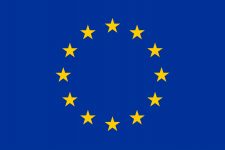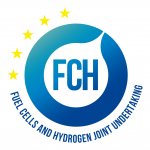The new year 2020 started already with a lot of energy in Switzerland. On January 8th, the Zurich University of Applied Sciences in Winterthur opened the doors of the FCHgo kidslab to 22 curious 4th graders of local primary school Altstadt.
In this photo story, you can follow the pupils and see what they learned about energy generation in the lab.
The children arrived early morning with their teacher Erwin Huonder at the FCHgo kidslab. They had just learned about electricity and heat at school.
Dr. Elisabeth Dumont from ZHAW welcomed them and introduced the plan for the day.


At first, the children watched the movie perpetuum mobile. And discussed the ghosts of energy, which appear in the movie. The kids recognized quickly electricity, heat, rotation (“Bewegung”) and light. They drew the ghosts on the blackboard and named them correctly. On the blackboard were also copper and zinc, because they were needed for an experiment with potatoes later.


… and hydrogen and oxygen for the work with the fuel cell later. The kids got a poster and playing cards with the ghosts. The headline here says ‘forces of nature’.


In a next step, it got more practical. The pupils built a potato battery with zinc, copper, a potato and an LED. They also drew and wrote about the ingredients needed for the battery.


They observed that the LED lit up, when they closed the electric circuit.


Then the kids were challenge to choose the ghosts present in the battery.


They are electricity, light, copper and zinc. Then the kids described what the ghosts do in the battery: which ghost ‘wakes’ up the other and how the energy is transferred from one ghost to another. This is what they found out: “Copper and zinc give their energy to the electricity. The electricity gives its energy to the light.”
Then the most exciting part of the lab began. The children got a model with a reversible hydrogen fuel cell. The goal: Produce hydrogen and get the air propeller running. The first step: built the solar-cell-electrolyzer-gas-tank-system. That sounds more complicated than it is.


Then everything was ready to perform the experiment and get the electrolyzer for hydrogen production going. A solar cell activated by the light of a lamp provided the electricity to transform water into hydrogen and oxygen. Some kids observed that more hydrogen is produced than oxygen.


After hydrogen and oxygen production, a fan was connected to the fuel cell and the kids observed that the fan rotated as long as there was some gas present in the tanks.


The children were asked to identify the ghosts and to tell what they do in the electrolyzer. This is what they said:
- In the solar cell, light wakes up the electricity. In the fuel cell (we used a reversible fuel cell, that worked here as an electrolyzer), electricity produces oxygen and hydrogen out of water.
- In the fuel cell hydrogen and oxygen make water and they drive electricity. Electricity drives the rotation.

This is was Lea wrote.

The End.
All photos in this story are from © Julia Obst 2020, courtesy ZHAW.



